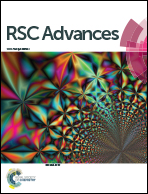Amphiphilic copolymer self-assembly of magnetic nanoparticles for construction of magnetically responsive photonic crystals based on steric hindrance†
Abstract
Herein, a facile, simple and rapid self-assembly of magnetic colloidal nanoparticles (MCNPs) to build magnetically responsive photonic crystals (MRPCs) was devolved. A nonionic amphiphilic random copolymer poly(styrene-co-vinylpyrrolidone) P(St-co-VP) with the monomer molar ratio of 1 : 9 was used not only as an emulsifier for miniemulsion self-assembly of Fe3O4 magnetic nanoclusters, but also as the coating material on the magnetic nanoclusters through itself assembly. The self-assembly of the magnetic nanocluster and the polymer coating were completed simultaneously without another polymerization process. The characterization of the MCNPs and the optical properties of the MRPCs were investigated in details. TEM showed that the MCNPs had regular spherical structures with an average diameter of 104.6 nm (RSD = 13.9%, n = 100). P(St-co-VP) self-assembly coating was confirmed by IR and XPS, and thermogravimetric analysis showed that the magnetite content was 76.15%. The large content of magnetite and the thin coating of the copolymer gave MCNPs the high saturated magnetization (Ms) of 52.60 emu g−1. Under an external magnetic field, the MCNPs could assemble MRPCs instantaneously and reversibly. The structural color covered entire visible spectrum by tuning the strength of the external magnetic field. On basis of the steric hindrance from neighboring PVP stretching chains, rather than electrostatic repulsion or solvation layer to counterbalance magnetic attraction, the MRPCs could tolerate the electrolyte as high as 0.10 mol L−1 and the variance of pH from 2.0–12.0. The stability of P(St-co-VP) self-assembly coating was testified through the invariability of the structural color of MRPCs after repeated washing, as well as the recovery of structural color after removing the electrolytes.



 Please wait while we load your content...
Please wait while we load your content...